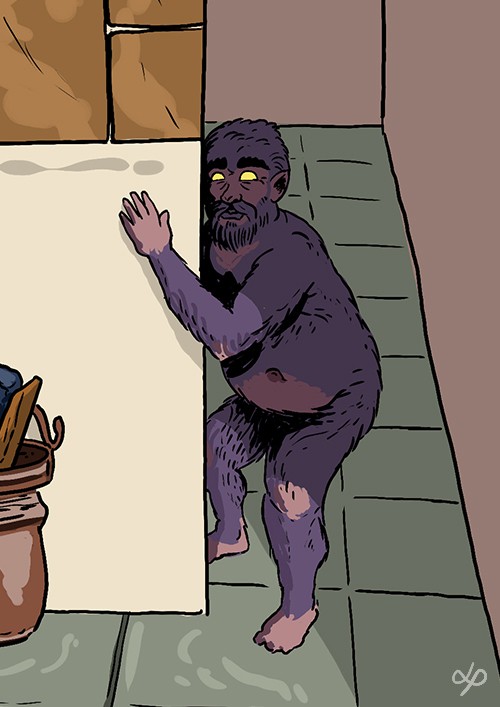 The Slavic home is the domain of a spirit called the Domovoy, a small, furry creature that resembles the resident family’s ancestor. In fact, it’s one way that the Slavs remember and revere their ancestors, by manifesting the old head of the family as a guardian spirit of their home. The soul of the ancestor was thought to stay behind after their death, to protect the family and increase their good fortune and wealth.
The Slavic home is the domain of a spirit called the Domovoy, a small, furry creature that resembles the resident family’s ancestor. In fact, it’s one way that the Slavs remember and revere their ancestors, by manifesting the old head of the family as a guardian spirit of their home. The soul of the ancestor was thought to stay behind after their death, to protect the family and increase their good fortune and wealth.
What it looks like & where to find it
If the original head of the family was male, the spirit would be seen as male - a Domovoy, and if it was female, it would be seen as female - a Domania. It bore the features of the deceased person, their face, their voice and their mannerisms (for example, if the person had a favourite cow, the spirit would show particular affection to it).
It was generally invisible, or hard to spot, whether because of shyness or just reclusiveness, it would not be seen unless it wanted to be seen. During those rare occasions when it shows itself, people report seeing a small, old person, covered head to toe in bushy hair. There’s a belief that hair is the center of life and magical power, so the hairier the Domovoy, the greater the family’s prosperity and wealth was. Some home spirits are naked, and others are dressed in the customary clothing of the ancestor’s people. Sometimes all you can see is its flashing eyes, moving in shadows. The resemblance to cats is not insignificant, and it’s not uncommon for a family to see a cat living in their home as their Domovoy. It must not be harmed in any way or else great misfortune would befall them.
“In the traditional Russian culture, cats were one of the most sacralized animals of the domestic space. Just like an icon, cats were not bought but received in exchange; it was considered a sin to kill a cat. Identification of the home spirit with a cat was apparently caused by the fact that the cat, just like the domovoy, seemed to be the image of a reborn soul, a kind of emanation of the ancestor.”
O.K. Ansimova and O.V. Golubkova , Mythological Characters of the Domestic Space in Russian Folk Beliefs - Lexicographic and Ethnographic Aspects
It can also inhabit other animal forms, such as dogs, bears and snakes. Speaking of snakes:
“The Bohemian Hospodaricek is believed to bring food and money and to warn the householder of impending danger. His symbol is the snake, which is also often called Hospodar, Hospodaricek, or Domovnicek. Such a snake lives behind the over or below the threshold; whoever kills him destroys the happiness and well-being of the family; and if he dies, the life of the master of the house must also end. He is very much attached to the family, especially to children; and in time of harvest, when there is no one in the house, he keeps watch over the home and looks after the cattle. Frequently two snakes live in the house, a male and a female; and similar ideas concerning snakes called Zmek, Smok, or Cmok are widely current among other Slavs as well.”
Jan Máchal, In The Mythology of All Races
Its favorite places in the home were warm, small and confined areas. It can be found behind the stove, inside the hearth, in the chimney, in the pechurka (small niche in the stove wall), under the golbets (low box near the stove which contained the passageway to the basement). In the old days stoves were huge and were the dominant feature in many homes, and due to its important role in keeping the family fed and warm, it even appeared in folk tales and was associated with some legendary characters.
Moving to a new home
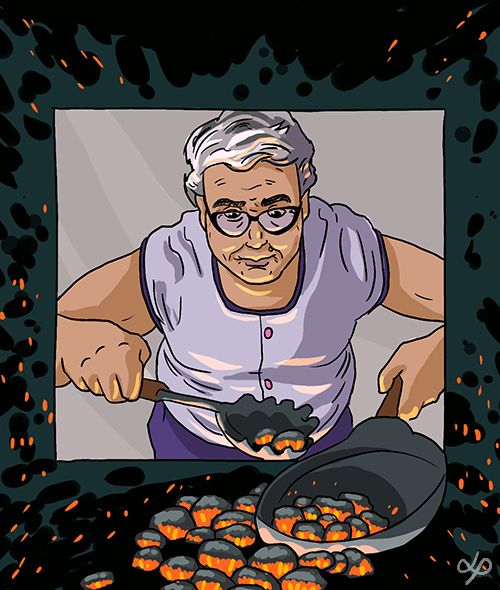 The Domovoy never leaves the home, not even when the home is left empty, or even when it burns down. It will stay inside and wait for a new family to accept or reject. Unless invited into a new home.
The Domovoy never leaves the home, not even when the home is left empty, or even when it burns down. It will stay inside and wait for a new family to accept or reject. Unless invited into a new home.
“When moving into a new home, a family never forgets to take their Domovoy. An old woman heats a stove in the old house and scrapes the cinders upon the fender, putting these at noon into a clean pan and covering it with a napkin. Opening the window and turning toward the corner of the room where the oven stands, she invited the Domovoy to come into the new house, after which she takes the pan with the coal into the new home where, at the open gate, he is awaited by the master and the mistress with bread and salt in their hands. Bowing low, they again invite him into the new dwelling, and the old woman, with the master of the house, first enters the room, carrying bread and salt in their hands. The old woman puts the pan by the fireside, and removing the cloth, shakes it toward all the corners to frighten away the Domovoy and then empties the coal into the oven, after which the pan is broken in pieces and buried below the front corner of the room.”
Jan Máchal, In The Mythology of All Races
Behaviour and temperament
Overall the Domovoy is a good spirit, kind and caring to those it vowed to protect.
“If susedko (another name for a Domovoy) liked someone, he would braid his hair. He would entangle hair, so you couldn’t comb it, and you shouldn’t cut it, or else he might get offended”
O.K. Ansimova and O.V. Golubkova , Mythological Characters of the Domestic Space in Russian Folk Beliefs - Lexicographic and Ethnographic Aspects
But if not given the proper respect and attention it would get upset and show its displeasure by making strange noises, clanking dishes, and slamming doors around the house. But if it's really angry it could take vengeance on the cattle (torture household cattle, plait horses' fur, and chase a horse till it foams) or even choke people while they’re asleep. The worst thing would be if it abandoned the home and left the family defenseless, at which point the people would fall ill and die. Just like with the Rusalka, what these spirits want above all else is respect.
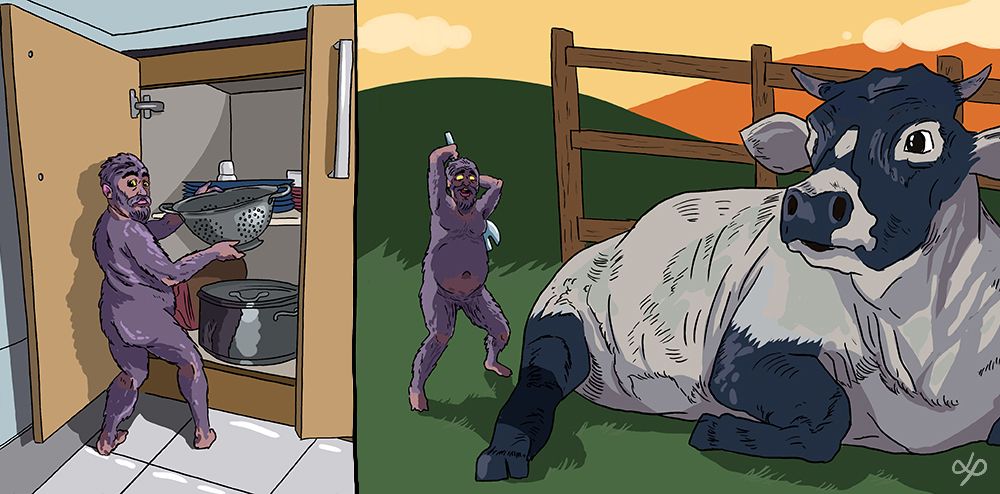
Divination
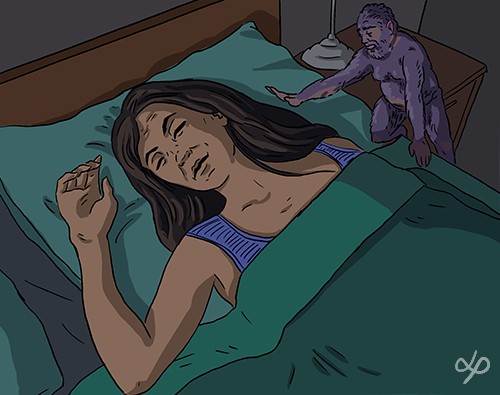 The thing the Domovoy is most famous for, other than its bad temper, is its power of seeing into the future. Some believe that a Domovoy will let itself be seen before an important event in a person’s life.
The thing the Domovoy is most famous for, other than its bad temper, is its power of seeing into the future. Some believe that a Domovoy will let itself be seen before an important event in a person’s life.
“At night, a shaggy bear fell on me and started to suffocate me. This was a domovoy who was driving me out of the house. I soon got married”
If it would approaches a sleeping person and laughs and caresses them with its "warm, hairy hand" (ew), it means it foresaw good things in their future. If sad events are coming, especially in the case of a family member’s death, it would howl, knock, and slam the door (which is similar to its behaviour when it's angry, so take its omens with a grain of salt). It can also foreshadow coming wars, great fires, and plagues.
Other names
Its name comes from the Indo-European root dom, which means house, home, abode, domain.
Other names for the Domovoy are: Děd, Dĕdek, Děduška (Czech); Did, Didko, Diduch, Domovyk (Ukrainian) Damavik (Belarusian); Dedek, Djadek; Šetek, Šotek (Czech) Skřítek (Czech); Škrata, Škriatok (Slovak); Škrat, Škratek (Slovenian); Skrzatek, Skrzat, Skrzot (Polish); Chozyain, Chozyainuško (Russian); Stopan (Bulgarian); Domovníček, Hospodáříček (Czech); Domaći (Croatian); Zmek, Smok, Ćmok (snake form).
The female spirit Domania can appear as: Domovikha (Russian);Damavukha (Belarusian); Kikimora (there’s enough information on her to write a whole article); Marukha; Volossatka.
Ancient origins and other household spirits
The ancient Slavs believed that spirits reside in trees, so when a tree was used in the construction of a building, the tree spirit would inhabit that building. Each structure within a home would be inhabited by a different spirit. The Domovoy lived and was in charge of the house, the Gumenik was in the storehouse, the Dvororoy lived in the courtyard, and the Ovinnik in the barn or the drying-room.
“The Ovinnik was also present in the sheaf of grain kept in the “sacred corner” of the dwelling under the icon and venerated along with it, and also in non-cultivated plant species that are kept in the house for propitiation or protection, such as branches of the birch tree and bunches of thistle. Such practices could be evidence that these beliefs have a pre-agrarian origin.”
Gasparini, Evel. "Slavic religion". Encyclopedia Britannica
The Bannik, who lived in the bathhouse, was the most dangerous and malicious of the home spirits. Slavic bathhouses used to be more like saunas, and were also a place where women could give birth, as well as practice divination, as it was endowed with vital forces. Just like the Domovoy, the Bannik had the gift of foresight. People would risk their own skin to consult with it - they would turn their bare backs in the half-open door of the bath. The Bannik would either gently stroke their back if it saw a bright future, otherwise it would strike their back with its claws.
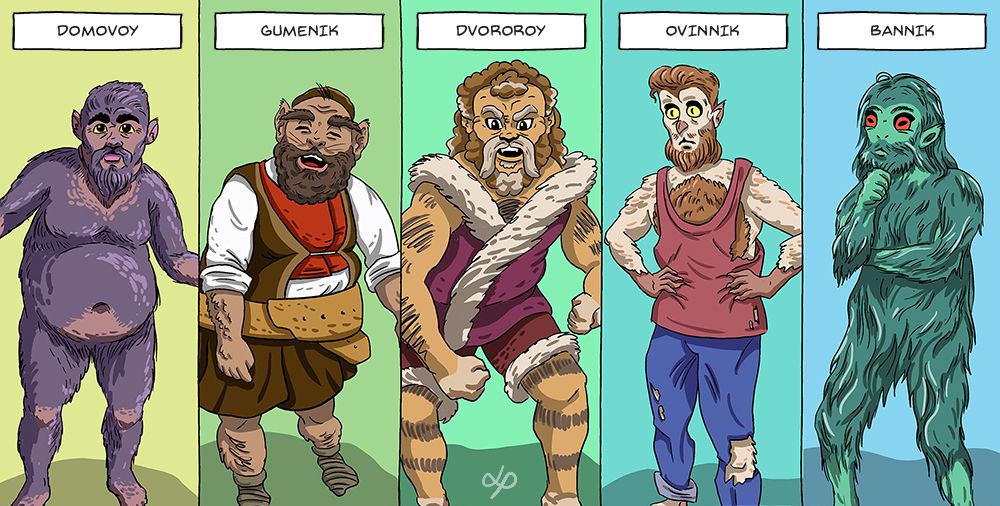
The Domania is not as widely spoken of as her male counterpart, even though, according to some writers, she was the original form of the household spirit, and the Domovoy were a later addition.
“The masculinization of female divinities - the custom of giving them male counterparts or rivals continued through the centuries in the folklore of the Eastern Slavs: leshiii (woodsprite), vodianoi (watersprite), banik (bathhouse spirit), and domovoi (house spirit) all appear to share and even supplant the role of the rozhanitsy, bereginy, vily and rusalki. Sometimes they are even given families to rule.”
Joanna Hubbs: Mother Russia: The Feminine Myth in Russian Culture
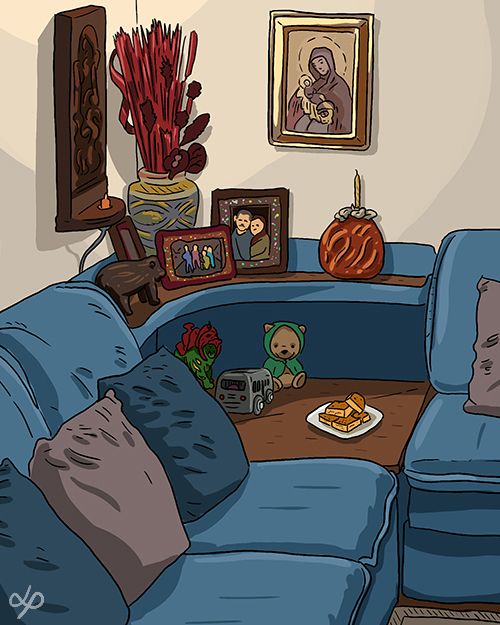 Significance
Significance
The belief in the Domovoy are still relevant today, and is important to both rural and urban people. Some express this belief by setting up “Domovoy corners” in their apartments, leaving food (bread, milk or sweets) and toys (a jar with buttons, beads, and other small shiny objects) for the spirit to enjoy. From ancient to modern times, people have seen their homes not only as places for people, but for mythological beings too, whether they were spirits coming from the forests, or the ancestors staying behind to look after their descendants, their presence makes the home a little bit more full of life. And who wouldn’t want to have a little, invisible grandparent in their home, watching out for them?
Sources
John Arnott Macculloch and Jan Máchal: The Mythology of All Races/Volume 3 (Celtic and Slavic), University of California Press, 1999
Joanna Hubbs: Mother Russia: The Feminine Myth in Russian Culture, Indiana University Press, 1988.
Gimbutas, Maria (1999). The Living Goddesses. United Kingdom: University of California Press.
Britannica, The Editors of Encyclopaedia. "Domovoy". Encyclopedia Britannica, 6 Aug. 2019, https://www.britannica.com/topic/domovoy. Accessed 5 February 2021.
Gasparini, Evel. "Slavic religion". Encyclopedia Britannica, 9 Apr. 2013, https://www.britannica.com/topic/Slavic-religion. Accessed 16 April 2021.
Ansimova O.K., Golubkova O.V. Mythological Characters of the Domestic Space in Russian Folk Beliefs - Lexicographic and Ethnographic Aspects - Archaeology, Ethnology & Anthropology of Eurasia. 2016-44(3)-130-138
Inga Zashikhina and Natalia Drannikova, Northern Russian and Norwegian Mythological Household Spirits of Inhabited Space Typology, Advances in Social Science, Education and Humanities Research, volume 360, European Multilingualism: Shaping Sustainable Educational and Social Environment (EMSSESE 2019), Atlantis Press, 2019
Comments (0)